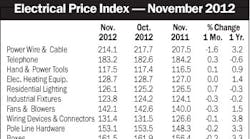Latest from Mag
People - Dec 21, 2012
Obituaries - Dec 21, 2012
November EPI Index Shows No Change
Housing Starts Dip 4% in November
Electrical Marketing - December 21, 2012
Around the Industry - Dec 21, 2012
Expanding its presence in light-emitting diodes (LEDs), Netherlands-based Royal Philips Electronics NV has agreed to acquire all of the outstanding shares of Color Kinetics Inc. for approximately $688 million in cash upon completion.
Boston-based Color Kinetics is a leader in designing and marketing innovative LED lighting systems, and its LED systems have been installed in more than 15,000 applications worldwide. For the past several years, the company’s booths at the LightFair trade shows have been packed with lighting designers, architects and other lighting professionals who wanted to learn how the Color Kinetics’ LED systems could be used for lighting effects in restaurants, clubs, stores, other retail establishments, and other high-end applications. Its products have been frequent winners in LightFair’s new product competition. Although lighting professionals are intrigued with how Color Kinetics’ lighting systems allow them to “paint” their lighting designs with a dazzling array of colors and special effects, they agree the potential for LEDs to cost-effectively produce white light is where they will have their greatest impact.
“We have long said LEDs are the future of illumination — not a passing novelty — and we’ve supported that view with an unwavering focus on the research and development of new technologies, sales channels, partnerships and industry initiatives to make it a reality,” said Bill Sims, president and CEO of Color Kinetics. “We believe that joining Philips, the global lighting leader, is in the best interest of our shareholders, customers, partners and employees. Our combined resources will produce the best possible entity to drive the LED lighting revolution forward.”
In building its positions as a leader in the LED market, Philips has made two other big acquisitions. In 2005, the company bought Agilent Technologies Inc. out of its Lumileds LED components joint venture for $950 million, giving it a leading position in high-power LED dies. In March, Philips completed a $71 million purchase of Canada’s TIR Systems Ltd., which specializes in white light-producing LED modules.
Philips said the Color Kinetics acquisition will help it become a leader in solid-state lighting (SSL) luminaires, and help lead the future global shift to more energy-efficient lighting solutions using LED sources.
“This acquisition uniquely positions Philips as a major player in the fast-growing SSL business with technology, expertise and intellectual property in all parts of the value chain of integrated LED-based lighting solutions,” said Theo van Deursen, chief executive of Philips’ Lighting division.
“The technological platform obtained through this acquisition will serve as a springboard for Philips to further create sustainable value through making innovative LED lighting solutions widely available. We admire Color Kinetics’ expertise, which they built up in only 10 years of existence, and we will foster the company’s creative and entrepreneurial flair in the future while boosting growth by integrating it into the global lighting leader.”
Van Deursen said Philips expects the market for LEDs to grow at more than 20 percent per year and reach $20-30 billion in 2025.
Joe Knisley, senior editorial consultant for EC&M magazine, has covered the lighting market for more than 40 years. He said the acquisition is big news in the lighting market.
“I’ve always considered Color Kinetics to be near the top in terms of innovation,” he said. “Their founders are very much into electronics, and they have a knowledge of control and color mixing. They made their fame from doing a lot of the specialized theatrical lighting and for hotels. Color Kinetics has the patents, and the company that has the patents is the company that is going to make the money.”
Thomas Griffiths, publisher/managing editor of Solid State Lighting Design, an online content provider that focuses on the SSL market, said Philips is “really consolidating” since they recently completed the acquisition of TIR Systems in Canada. “This acquisition puts the two leaders in lighting modules under the Philips banner, and brings them a lot of key intellectual property with the TIR and Color Kinetics combination.” He added that TIR and Color Kinetics had some patent disputes going on and had a significant overlap in some market areas.
When comparing the LED product offering of Philips Lighting to those offered by its two largest competitors, Sylvania Lighting, Danvers, Mass., and GE Lighting, Cleveland, Griffiths said, “Philips is now the only one with a complete solution set: the unpackaged LED (commonly called the ‘die’ or ‘chip’); the packaged LED (lamp) from Lumileds; the light engines and lighting modules from TIR/Color Kinetics; and their own fixtures and luminaires. I believe they are best positioned for the solid-state lighting future.
“Osram has a similar range, but there’s a hole at the light engines/modules. GE has been more specialized, picking up an LED partner in Nichia (very high-quality LED lamps), and aiming their modules/luminaires at more industrial markets such as traffic lights.”
Lighting experts believe that in the not-too-distant future light-emitting diodes (LEDs) and a sister technology, organic light-emitting diodes (OLEDs), will compete with incandescent, halogen, fluorescent and other more traditional lamps. LEDs and OLEDs have the potential to replace standard incandescent bulbs and even compact fluorescent lamps (CFLs) because of their growing efficiency and increasingly lower costs. They are expected to win market share when they cost-effectively produce the white light currently used in general indoor lighting applications. While some long-life fluorescent lamps can last up to 10,000 hours, and the most-efficient incandescent or halogen lamps can last several thousand hours, lighting experts expect LEDs to produce white light for more than 50,000 hours.
Color Kinetics had 2006 sales of approximately $65 million. The company’s sales have grown at a compound annual growth rate of 31 percent from 2001 to 2006. Operating margins are expected to increase as the company benefits from economies of scale. In addition to its product sales, Color Kinetics has a fast-growing licensing income stream that adds significantly to its value. This transaction is subject to the approval of Color Kinetics’ shareholders, as well as to customary regulatory clearance, and is expected to close in the second half of 2007.

